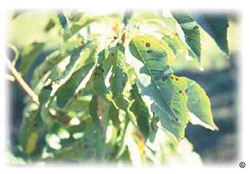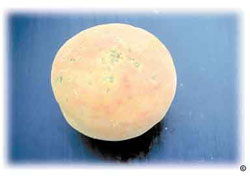Coryneum blight, also called shot hole disease, California blight, peach blight or pustular spot, is caused by a fungus that attacks mainly peaches and apricots, and less often, sweet cherries.
Early symptoms appear as small, red spots that enlarge and become purple with a white center. These spots will drop out of the leaf, leaving a shot hole.  Numerous shot holes give a tattered appearance to leaves. Coryneum blight also will infect leaf buds, blossom buds and twigs, and cause small, sunken twig cankers. Infection to these areas weakens a tree.
Numerous shot holes give a tattered appearance to leaves. Coryneum blight also will infect leaf buds, blossom buds and twigs, and cause small, sunken twig cankers. Infection to these areas weakens a tree.
More serious damage shows up as blemished or disfigured fruit. Spots may appear on the fruit anywhere from 10 to 12 weeks prior to harvest and throughout the post-harvest period. Spots are sunken, brownish and up to one-half inch in diameter. During optimal conditions, spots will coalesce and may cause skin cracking or gumming.
Optimal conditions for disease include frequent light showers combined with wind and prolonged warm weather of 70 to 80 degrees  Fahrenheit. Wind isn’t required but will help spread the disease as spores are picked up and moved to uninfected branches. Blight will spread rapidly within a tree, but will spread more slowly from tree to tree. Be especially alert to blight in spring and early summer.
Fahrenheit. Wind isn’t required but will help spread the disease as spores are picked up and moved to uninfected branches. Blight will spread rapidly within a tree, but will spread more slowly from tree to tree. Be especially alert to blight in spring and early summer.
Unfortunately, Coryneum blight is difficult to eradicate. Buds and twigs may produce spores for up to 3 years. The fungus doesn’t overwinter in infected leaves.
Pruning out dead and infected wood is essential to managing Coryneum blight. Chemical control also is necessary to manage an infested orchard. In the fall, Bordeaux Mixture 10-10-100 or fixed copper may be applied immediately after leaf drop. Always follow label instructions.
Apply fixed copper materials in the spring before leaves emerge between petal fall and the “shuck fall” stage. The shuck fall stage is the time when trees naturally drop their immature fruits.
For more information, see the following Colorado State University Extension fact sheet(s).



